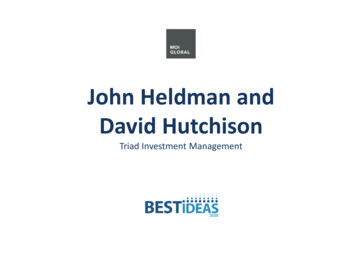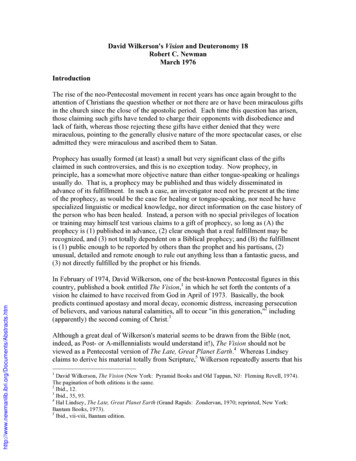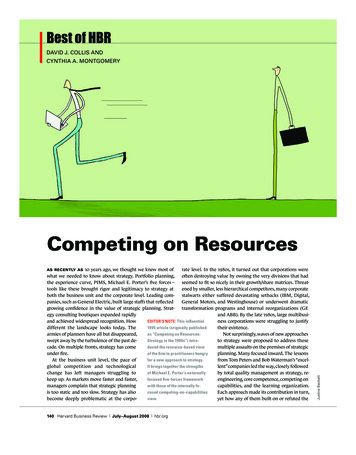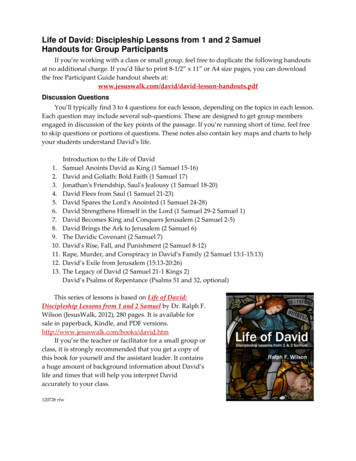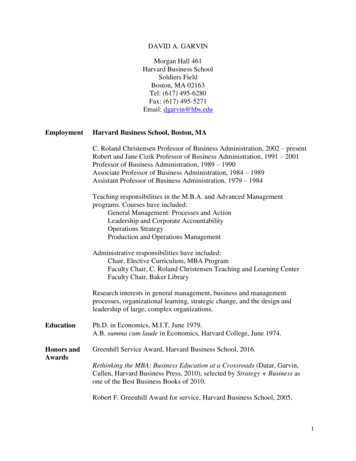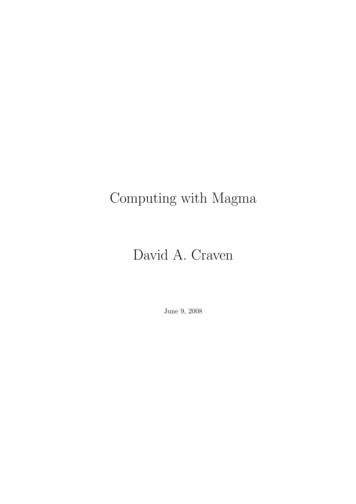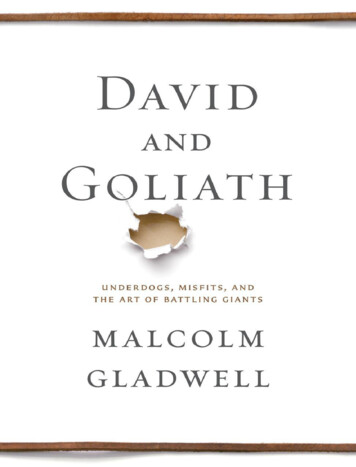
Transcription
Begin ReadingTable of ContentsNewslettersCopyright PageIn accordance with the U.S. Copyright Act of 1976,the scanning, uploading, and electronic sharing of anypart of this book without the permission of thepublisher constitute unlawful piracy and theft of theauthor’s intellectual property. If you would like to use
material from the book (other than for reviewpurposes), prior written permission must be obtained bycontacting the publisher at permissions@hbgusa.com.Thank you for your support of the author’s rights.
For A.L. and forS.F., a realunderdog
But the Lord said to Samuel, “Do notlook on his appearance or on theheight of his stature, because I haverejected him; for the Lord does notsee as mortals see; they look on theoutward appearance, but the Lordlooks on the heart.”1 Samuel 16:7
Introduction
Goliath“Am I a dog that you shouldcome to me with sticks?”
1.At the heart of ancient Palestine is theregion known as the Shephelah, a seriesof ridges and valleys connecting theJudaean Mountains to the east with thewide, flat expanse of the Mediterraneanplain. It is an area of breathtakingbeauty, home to vineyards and wheatfields and forests of sycamore andterebinth. It is also of great strategicimportance.Over the centuries, numerous battleshave been fought for control of theregion because the valleys rising fromthe Mediterranean plain offer those onthe coast a clear path to the cities of
Hebron, Bethlehem, and Jerusalem in theJudaean highlands. The most importantvalley is Aijalon, in the north. But themost storied is the Elah. The Elah waswhere Saladin faced off against theKnights of the Crusades in the twelfthcentury. It played a central role in theMaccabean wars with Syria more than athousand years before that, and, mostfamously, during the days of the OldTestament, it was where the fledglingKingdom of Israel squared off againstthe armies of the Philistines.The Philistines were from Crete. Theywere a seafaring people who had movedto Palestine and settled along the coast.The Israelites were clustered in themountains, under the leadership of King
Saul. In the second half of the eleventhcentury BCE, the Philistines began movingeast, winding their way upstream alongthe floor of the Elah Valley. Their goalwas to capture the mountain ridge nearBethlehem and split Saul’s kingdom intwo. The Philistines were battle-testedand dangerous, and the sworn enemies ofthe Israelites. Alarmed, Saul gatheredhis men and hastened down from themountains to confront them.The Philistines set up camp along thesouthern ridge of the Elah. The Israelitespitched their tents on the other side,along the northern ridge, which left thetwo armies looking across the ravine ateach other. Neither dared to move. To
attack meant descending down the hilland then making a suicidal climb up theenemy’s ridge on the other side. Finally,the Philistines had enough. They senttheir greatest warrior down into thevalley to resolve the deadlock one onone.He was a giant, six foot nine at least,wearing a bronze helmet and full bodyarmor. He carried a javelin, a spear, anda sword. An attendant preceded him,carrying a large shield. The giant facedthe Israelites and shouted out: “Chooseyou a man and let him come down to me!If he prevail in battle against me andstrike me down, we shall be slaves toyou. But if I prevail and strike himdown, you will be slaves to us and serve
us.”In the Israelite camp, no one moved.Who could win against such a terrifyingopponent? Then, a shepherd boy whohad come down from Bethlehem to bringfood to his brothers stepped forward andvolunteered. Saul objected: “You cannotgo against this Philistine to do battlewith him, for you are a lad and he is aman of war from his youth.” But theshepherd was adamant. He had facedmore ferocious opponents than this, heargued. “When the lion or the bearwould come and carry off a sheep fromthe herd,” he told Saul, “I would go afterhim and strike him down and rescue itfrom his clutches.” Saul had no other
options. He relented, and the shepherdboy ran down the hill toward the giantstanding in the valley. “Come to me, thatI may give your flesh to the birds of theheavens and the beasts of the field,” thegiant cried out when he saw hisopponent approach. Thus began one ofhistory’s most famous battles. Thegiant’s name was Goliath. The shepherdboy’s name was David.
2.David and Goliath is a book about whathappens when ordinary people confrontgiants. By “giants,” I mean powerfulopponents of all kinds—from armies andmightywarriorstodisability,misfortune, and oppression. Eachchapter tells the story of a differentperson—famous or unknown, ordinaryor brilliant—who has faced an outsizechallenge and been forced to respond.Should I play by the rules or follow myown instincts? Shall I persevere or giveup? Should I strike back or forgive?Through these stories, I want toexplore two ideas. The first is that much
of what we consider valuable in ourworld arises out of these kinds oflopsided conflicts, because the act offacing overwhelming odds producesgreatness and beauty. And second, thatwe consistently get these kinds ofconflicts wrong. We misread them. Wemisinterpret them. Giants are not whatwe think they are. The same qualitiesthat appear to give them strength areoften the sources of great weakness. Andthe fact of being an underdog can changepeople in ways that we often fail toappreciate: it can open doors and createopportunities and educate and enlightenand make possible what might otherwisehave seemed unthinkable. We need abetter guide to facing giants—and there
is no better place to start that journeythan with the epic confrontation betweenDavid and Goliath three thousand yearsago in the Valley of Elah.When Goliath shouted out to theIsraelites, he was asking for what wasknown as “single combat.” This was acommon practice in the ancient world.Two sides in a conflict would seek toavoid the heavy bloodshed of openbattle by choosing one warrior torepresent each in a duel. For example,the first-century B C E Roman historianQuintus Claudius Quadrigarius tells ofan epic battle in which a Gaul warriorbegan mocking his Roman opponents.“This immediately aroused the great
indignation of one Titus Manlius, a youthof the highest birth,” Quadrigariuswrites. Titus challenged the Gaul to aduel:He stepped forward, and would notsuffer Roman valour to be shamefullytarnished by a Gaul. Armed with alegionary’s shield and a Spanishsword, he confronted the Gaul. Theirfight took place on the very bridge[over the Anio River] in the presenceof both armies, amid greatapprehension. Thus they confrontedeach other: the Gaul, according to hismethod of fighting, with shieldadvanced and awaiting an attack;
Manlius, relying on courage ratherthan skill, struck shield against shieldand threw the Gaul off balance.While the Gaul was trying to regainthe same position, Manlius againstruck shield against shield and againforced the man to change his ground.In this fashion he slipped under theGaul’s sword and stabbed him in thechest with his Spanish blade. Afterhe had slain him, Manlius cut off theGaul’s head, tore off his tongue andput it, covered as it was with blood,around his own neck.This is what Goliath was expecting—awarrior like himself to come forward for
hand-to-hand combat. It never occurredto him that the battle would be fought onanything other than those terms, and heprepared accordingly. To protecthimself against blows to the body, hewore an elaborate tunic made up ofhundreds of overlapping bronze fishlikescales. It covered his arms and reachedto his knees and probably weighed morethan a hundred pounds. He had bronzeshin guards protecting his legs, withattached bronze plates covering his feet.He wore a heavy metal helmet. He hadthree separate weapons, all optimizedfor close combat. He held a thrustingjavelin made entirely of bronze, whichwas capable of penetrating a shield oreven armor. He had a sword on his hip.
And as his primary option, he carried aspecial kind of short-range spear with ametal shaft as “thick as a weaver’sbeam.” It had a cord attached to it and anelaborate set of weights that allowed itto be released with extraordinary forceand accuracy. As the historian MosheGarsiel writes, “To the Israelites, thisextraordinary spear, with its heavy shaftplus long and heavy iron blade, whenhurled by Goliath’s strong arm, seemedcapable of piercing any bronze shieldand bronze armor together.” Can you seewhy no Israelite would come forward tofight Goliath?Then David appears. Saul tries togive him his own sword and armor so at
least he’ll have a fighting chance. Davidrefuses. “I cannot walk in these,” hesays, “for I am unused to it.” Instead hereaches down and picks up five smoothstones, and puts them in his shoulderbag. Then he descends into the valley,carrying his shepherd’s staff. Goliathlooks at the boy coming toward him andis insulted. He was expecting to dobattle with a seasoned warrior. Insteadhe sees a shepherd—a boy from one ofthe lowliest of all professions—whoseems to want to use his shepherd’s staffas a cudgel against Goliath’s sword.“Am I a dog,” Goliath says, gesturing atthe staff, “that you should come to mewith sticks?”What happens next is a matter of
legend. David puts one of his stones intothe leather pouch of a sling, and he firesat Goliath’s exposed forehead. Goliathfalls, stunned. David runs toward him,seizes the giant’s sword, and cuts off hishead. “The Philistines saw that theirwarrior was dead,” the biblical accountreads, “and they fled.”The battle is won miraculously by anunderdog who, by all expectations,should not have won at all. This is theway we have told one another the storyover the many centuries since. It is howthe phrase “David and Goliath” hascome to be embedded in our language—as a metaphor for improbable victory.And the problem with that version of the
events is that almost everything about itis wrong.
3.Ancient armies had three kinds ofwarriors. The first was cavalry—armedmen on horseback or in chariots. Thesecond was infantry—foot soldierswearing armor and carrying swords andshields. The third were projectilewarriors, or what today would be calledartillery: archers and, most important,slingers. Slingers had a leather pouchattached on two sides by a long strand ofrope. They would put a rock or a leadball into the pouch, swing it around inincreasingly wider and faster circles,and then release one end of the rope,hurling the rock forward.
Slinging took an extraordinary amountof skill and practice. But in experiencedhands, the sling was a devastatingweapon. Paintings from medieval timesshow slingers hitting birds in midflight.Irish slingers were said to be able to hita coin from as far away as they couldsee it, and in the Old Testament Book ofJudges, slingers are described as beingaccurate within a “hair’s breadth.” Anexperienced slinger could kill orseriously injure a target at a distance ofup to two hundred yards.1 The Romanseven had a special set of tongs made justto remove stones that had beenembedded in some poor soldier’s bodyby a sling. Imagine standing in front of a
Major League Baseball pitcher as heaims a baseball at your head. That’swhat facing a slinger was like—onlywhat was being thrown was not a ball ofcork and leather but a solid rock.The historian Baruch Halpern arguesthat the sling was of such importance inancient warfare that the three kinds ofwarriors balanced one another, like eachgesture in the game of rock, paper,scissors. With their long pikes andarmor, infantry could stand up tocavalry. Cavalry could, in turn, defeatprojectile warriors, because the horsesmoved too quickly for artillery to takeproper aim. And projectile warriorswere deadly against infantry, because abig lumbering soldier, weighed down
with armor, was a sitting duck for aslinger who was launching projectilesfrom a hundred yards away. “This iswhy the Athenian expedition to Sicilyfailed in the Peloponnesian War,”Halpern writes. “Thucydides describesat length how Athens’s heavy infantrywas decimated in the mountains by locallight infantry, principally using thesling.”Goliath is heavy infantry. He thinksthat he is going to be engaged in a duelwith another heavy-infantryman, in thesame manner as Titus Manlius’s fightwith the Gaul. When he says, “Come tome, that I may give your flesh to thebirds of the heavens and the beasts of the
field,” the key phrase is “come to me.”He means come right up to me so that wecan fight at close quarters. When Saultries to dress David in armor and givehim a sword, he is operating under thesame assumption. He assumes David isgoing to fight Goliath hand to hand.David, however, has no intention ofhonoring the rituals of single combat.When he tells Saul that he has killedbears and lions as a shepherd, he doesso not just as testimony to his couragebut to make another point as well: that heintends to fight Goliath the same way hehas learned to fight wild animals—as aprojectile warrior.H e runs toward Goliath, becausewithout armor he has speed and
maneuverability. He puts a rock into hissling, and whips it around and around,faster and faster at six or sevenrevolutions per second, aiming hisprojectile at Goliath’s forehead—thegiant’s only point of vulnerability. EitanHirsch, a ballistics expert with theIsraeli Defense Forces, recently did aseries of calculations showing that atypical-size stone hurled by an expertslinger at a distance of thirty-five meterswould have hit Goliath’s head with avelocity of thirty-four meters per second—more than enough to penetrate hisskull and render him unconscious ordead. In terms of stopping power, that isequivalent to a fair-size modern
handgun. “We find,” Hirsch writes, “thatDavid could have slung and hit Goliathin little more than one second—a time sobrief that Goliath would not have beenable to protect himself and during whichhe would be stationary for all practicalpurposes.”What could Goliath do? He wascarrying over a hundred pounds ofarmor. He was prepared for a battle atclose range, where he could stand,immobile, warding off blows with hisarmor and delivering a mighty thrust ofhis spear. He watched David approach,first with scorn, then with surprise, andthen with what can only have beenhorror—as it dawned on him that thebattle he was expecting had suddenly
changed shape.“You come against me with swordand spear and javelin,” David said toGoliath, “but I come against you in thename of the Lord Almighty, the God ofthe armies of Israel, whom you havedefied. This day the Lord will deliveryou into my hands, and I’ll strike youdown and cut off your head. All thosegathered here will know that it is not bysword or spear that the Lord saves; forthe battle is the Lord, and he will giveall of you into our hands.”Twice David mentions Goliath’ssword and spear, as if to emphasize howprofoundly different his intentions are.Then he reaches into his shepherd’s bag
for a stone, and at that point no onewatching from the ridges on either sideof the valley would have consideredDavid’s victory improbable. David wasa slinger, and slingers beat infantry,hands down.“Goliath had as much chance againstDavid,”thehistorianRobertDohrenwend writes, “as any Bronze Agewarrior with a sword would have hadagainst an [opponent] armed with a .45automatic pistol.”2
4.Why has there been so muchmisunderstanding around that day in theValley of Elah? On one level, the duelreveals the folly of our assumptionsabout power. The reason King Saul isskeptical of David’s chances is thatDavid is small and Goliath is large. Saulthinks of power in terms of physicalmight. He doesn’t appreciate that powercan come in other forms as well—inbreaking rules, in substituting speed andsurprise for strength. Saul is not alone inmaking this mistake. In the pages thatfollow, I’m going to argue that wecontinue to make that error today, in
ways that have consequences foreverything from how we educate ourchildren to how we fight crime anddisorder.But there’s a second, deeper issuehere. Saul and the Israelites think theyknow who Goliath is. They size him upand jump to conclusions about what theythink he is capable of. But they do notreally see him. The truth is that Goliath’sbehavior is puzzling. He is supposed tobe a mighty warrior. But he’s not actinglike one. He comes down to the valleyfloor accompanied by an attendant—aservant walking before him, carrying ashield. Shield bearers in ancient timesoften accompanied archers into battlebecause a soldier using a bow and
arrow had no free hand to carry any kindof protection on his own. But why doesGoliath, a man calling for sword-onsword single combat, need to be assistedby a third party carrying an archer’sshield?What’s more, why does he say toDavid, “Come to me”? Why can’tGoliath go to David? The biblicalaccount emphasizes how slowly Goliathmoves, which is an odd thing to sayabout someone who is alleged to be abattle hero of infinite strength. In anycase, why doesn’t Goliath respond muchsooner to the sight of David comingdown the hillside without any sword orshield or armor? When he first sees
David, his first reaction is to be insulted,when he should be terrified. He seemsoblivious of what’s happening aroundhim. There is even that strange commentafter he finally spots David with hisshepherd’s staff: “Am I a dog that youshould come to me with sticks?” Sticksplural? David is holding only one stick.What many medical experts nowbelieve, in fact, is that Goliath had aserious medical condition. He looks andsounds like someone suffering from whatis called acromegaly—a disease causedby a benign tumor of the pituitary gland.The tumor causes an overproduction ofhuman growth hormone, which wouldexplain Goliath’s extraordinary size.(The tallest person in history, Robert
Wadlow, suffered from acromegaly. Athis death, he was eight foot eleveninches, and apparently still growing.)And furthermore, one of the commonside effects of acromegaly is visionproblems. Pituitary tumors can grow tothe point where they compress thenerves leading to the eyes, with theresult that people with acromegaly oftensuffer from severely restricted sight anddiplopia, or double vision. Why wasGoliath led onto the valley floor by anattendant? Because the attendant was hisvisual guide. Why does he move soslowly? Because the world around himis a blur. Why does it take him so long tounderstand that David has changed the
rules? Because he doesn’t see Daviduntil David is up close. “Come to me,that I may give your flesh to the birds ofthe heavens and the beasts of the field,”he shouts out, and in that request there isa hint of his vulnerability. I need you tocome to me because I cannot locate youotherwi se. And then there is theotherwise inexplicable “Am I a dog thatyou come to me with sticks?” David hadonly one stick. Goliath saw two.What the Israelites saw, from high onthe ridge, was an intimidating giant. Inreality, the very thing that gave the gianthis size was also the source of hisgreatest weakness. There is an importantlesson in that for battles with all kinds ofgiants. The powerful and the strong are
not always what they seem.David came running toward Goliath,powered by courage and faith. Goliathwas blind to his approach—and then hewas down, too big and slow and blurryeyed to comprehend the way the tableshad been turned. All these years, we’vebeen telling these kinds of stories wrong.David and Goliath is about getting themright.1 The modern world record forslinging a stone was set in 1981 by LarryBray: 437 meters. Obviously, at thatdistance, accuracy suffers.2 The Israeli minister of defenseMoshe Dayan—the architect of Israel’s
astonishing victory in the 1967 Six-DayWar—also wrote an essay on the storyof David and Goliath. According toDayan, “David fought Goliath not withinferior but (on the contrary) withsuperior weaponry; and his greatnessconsisted not in his being willing to goout into battle against someone farstronger than he was. But in his knowinghow to exploit a weapon by which afeeble person could seize the advantageand become stronger.”
Part One
The Advantages ofDisadvantages (and theDisadvantages ofAdvantages)Some pretend to be rich, yet havenothing; others pretend to be poor, yethave great wealth.Proverbs 13:7
Chapter One
Vivek Ranadivé“It was really random. I mean,my father had never playedbasketball before.”
1.When Vivek Ranadivé decided to coachhis daughter Anjali’s basketball team, hesettled on two principles. The first wasthat he would never raise his voice. Thiswas National Junior Basketball—theLittle League of basketball. The teamwas made up mostly of twelve-yearolds, and twelve-year-olds, he knewfrom experience, did not respond well toshouting. He would conduct business onthe basketball court, he decided, thesame way he conducted business at hissoftware firm. He would speak calmlyand softly, and he would persuade thegirls of the wisdom of his approach with
appeals to reason and common sense.The second principle was moreimportant. Ranadivé was puzzled by theway Americans play basketball. He isfrom Mumbai. He grew up with cricketand soccer. He would never forget thefirst time he saw a basketball game. Hethought it was mindless. Team A wouldscore and then immediately retreat to itsown end of the court. Team B wouldpass the ball in from the sidelines anddribble it into Team A’s end, whereTeam A was patiently waiting. Then theprocess would reverse itself.A regulation basketball court isninety-four feet long. Most of the time, ateam would defend only about twentyfour feet of that, conceding the other
seventy feet. Occasionally teams playeda full-court press—that is, they contestedtheir opponent’s attempt to advance theball up the court. But they did it for onlya few minutes at a time. It was as if therewere a kind of conspiracy in thebasketball world about the way the gameought to be played, Ranadivé thought,and that conspiracy had the effect ofwidening the gap between good teamsand weak teams. Good teams, after all,had players who were tall and coulddribble and shoot well; they couldcrisply execute their carefully preparedplays in their opponent’s end. Why, then,did weak teams play in a way that madeit easy for good teams to do the very
things that they were so good at?Ranadivé looked at his girls. Morganand Julia were serious basketballplayers. But Nicky, Angela, Dani, Holly,Annika, and his own daughter, Anjali,had never played the game before. Theyweren’t all that tall. They couldn’t shoot.They weren’t particularly adept atdribbling. They were not the sort whoplayed pickup games at the playgroundevery evening. Ranadivé lives in MenloPark, in the heart of California’s SiliconValley. His team was made up of, asRanadivé put it, “little blond girls.”These were the daughters of nerds andcomputer programmers. They worked onscience projects and read long andcomplicated books and dreamed about
growing up to be marine biologists.Ranadivé knew that if they played theconventional way—if they let theiropponents dribble the ball up the courtwithout opposition—they would almostcertainly lose to the girls for whombasketball was a passion. Ranadivé hadcome to America as a seventeen-yearold with fifty dollars in his pocket. Hewas not one to accept losing easily. Hissecond principle, then, was that his teamwould play a real full-court press—every game, all the time. The team endedup at the national championships. “It wasreally random,” Anjali Ranadivé said. “Imean, my father had never playedbasketball before.”
2.Suppose you were to total up all thewars over the past two hundred yearsthat occurred between very large andvery small countries. Let’s say that oneside has to be at least ten times larger inpopulation and armed might than theother. How often do you think the biggerside wins? Most of us, I think, would putthat number at close to 100 percent. Atenfold difference is a lot. But the actualanswer may surprise you. When thepolitical scientist Ivan Arreguín-Toft didthe calculation a few years ago, what hecame up with was 71.5 percent. Justunder a third of the time, the weaker
country wins.Arreguín-Toft then asked the questionslightly differently. What happens inwars between the strong and the weakwhen the weak side does as David didand refuses to fight the way the biggerside wants to fight, using unconventionalor guerrilla tactics? The answer: inthose cases, the weaker party’s winningpercentage climbs from 28.5 percent to63.6 percent. To put that in perspective,the United States’ population is ten timesthe size of Canada’s. If the two countrieswent to war and Canada chose to fightunconventionally, history would suggestthat you ought to put your money onCanada.We think of underdog victories as
improbable events: that’s why the storyof David and Goliath has resonated sostrongly all these years. But ArreguínToft’s point is that they aren’t at all.Underdogs win all the time. Why, then,are we so shocked every time a Davidbeats a Goliath? Why do weautomatically assume that someone whois smaller or poorer or less skilled isnecessarily at a disadvantage?One of the winning underdogs onArreguín-Toft’s list, for example, was T.E. Lawrence (or, as he is better known,Lawrence of Arabia), who led the Arabrevolt against the Turkish armyoccupying Arabia near the end of theFirst World War. The British were
helping the Arabs in their uprising, andtheir goal was to destroy the longrailroad the Turks had built running fromDamascus deep into the Hejaz Desert.It was a daunting task. The Turks hada formidable modern army. Lawrence,by contrast, commanded an unruly bandof Bedouin. They were not skilledtroops. They were nomads. Sir ReginaldWingate, one of the British commandersin the region, called them “an untrainedrabble, most of whom have never fired arifle.” But they were tough and theywere mobile. The typical Bedouinsoldier carried no more than a rifle, ahundred rounds of ammunition, andforty-five pounds of flour, which meantthat he could travel as much as 110
miles a day across the desert, even insummer. They carried no more than apint of drinking water, since they wereso good at finding water in the desert.“Our cards were speed and time, nothitting power,” Lawrence wrote. “Ourlargest available resources were thetribesmen, men quite unused to formalwarfare, whose assets were e of the country, courage.” Theeighteenth-century general Maurice deSaxe famously said that the art of warwas about legs, not arms, andLawrence’s troops were all legs. In onetypical stretch in the spring of 1917, hismen dynamited sixty rails and cut a
telegraph line at Buair on March 24,sabotaged a train and twenty-five rails atAbu al-Naam on March 25, dynamitedfifteen rails and cut a telegraph line atIstabl Antar on March 27, raided aTurkish garrison and derailed a train onMarch 29, returned to Buair andsabotaged the railway line again onMarch 31, dynamited eleven rails atHedia on April 3, raided the train line inthe area of Wadi Daiji on April 4 and 5,and attacked twice on April 6.Lawrence’s masterstroke was anassault on the port town of Aqaba. TheTurks expected an attack from Britishships patrolling the waters of the Gulf ofAqaba to the west. Lawrence decided toattack from the east instead, coming at
the city from the unprotected desert, andto do that, he led his men on anaudacious, six-hundred-mile loop—upfrom the Hejaz, north into the Syriandesert, and then back down towardAqaba. This was in summer, throughsome of the most inhospitable land in theMiddle East, and Lawrence tacked on aside trip to the outskirts of Damascus inorder to mislead the Turks about hisintentions. “This year the valley seemedcreeping with horned vipers and puffadders, cobras and black snakes,”Lawrence writes in Seven Pillars ofWisdom about one stage in the journey:We could not lightly draw water after
dark, for there were snakesswimming in the pools or clusteringin knots around their brinks. Twicepuff-adders came twisting into thealert ring of our debating coffeecircle. Three of our men died ofbites; four recovered after great fearand pain, and a swelling of thepoisoned limb. Howeitat treatmentwas to bind up the part with snakeskin plaster, and read chapters of theKoran to the sufferer until he died.When they finally arrived at Aqaba,Lawrence’s band of several hundredwarriors killed or captured twelvehundred Turks and lost only two men.
The Turks simply had not thought thattheir opponent would be crazy enough tocome at them from the desert.SirReginaldWingatecalledLawrence’s men an “untrained rabble.”He saw the Turks as the overwhelmingfavorites. But can you see how strangethat was? Having lots of soldiers andweapons and resources—as the Turksdid—is an advantage. But it makes youimmobile and puts you on the defensive.Meanwhile, movement, endurance,individual intelligence, knowledge of thecountry,andcourage—whichLawrence’s men had in abundance—allowed them to do the impossible,namely, attack Aqaba from the east, astrategy so audacious that the Turks
never saw it coming. There is a set ofadvantages that have to do with materialresources, and there is a set that have todo with the absence of materialresources—and the reason underdogswin as often as they do is that the latteris sometimes every bit the equal of theformer.For some reason, this is a verydifficult lesson for us to learn. We have,I think, a very rigid and limiteddefinition of what an advantage is. Wethink of things as helpful that actuallyaren’t and think of other things asunhelpful that in reality leave us strongerand wiser. Part One of David andGoliath is an attempt to explore the
consequences of that error. When we seethe giant, why do we automaticallyassume the battle is his for the winning?And what does it tak
David and Goliath is a book about what happens when ordinary people confront giants. By “giants,” I mean powerful opponents of all kinds—from armies and mighty warriors to disability, misfortune, and oppression. Each chapter tells the story of a different person—famous o
